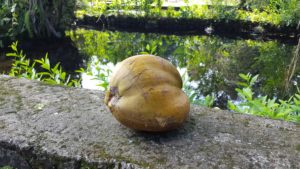By Kate Goodwin, Young Adult Wellness Medical Supervisor

Coconut has many uses and health benefits
The tropical coconut is an incredible superfood with endless uses, especially in Polynesian cultures. The Hawaiians used “Niu” or coconut for drink, food, thatching, hats, baskets, furniture, mats, cordage, clothing, charcoal, brooms, fans, ornaments, musical instruments, shampoo, containers, oil for fuel, light, ointments, soap and more.
Traditionally, a coconut palm was planted at a Hawaiian’s birth with a he’e (octopus) under it for fertilizer. After the tree fruits at age seven, it will continue to fruit for 70-100 years to provide food for the individual or community. Just one tree can produce 50 coconuts a year!
Coconut meat contains high quantities of lauric acid, a rare medium-chain saturated fatty acid. Lauric acid is the reason coconut oil is so good for your skin, it can reduce bacterial and fungal infections while moisturizing. Consuming the coconut meat provides B vitamins, vitamin C, calcium, iron, magnesium, phosphorus, potassium and zinc. Coconut water is an alkali producer in the digestive system and can help balance the body’s pH. The water inside a coconut is sterile, yet packed with nutrients and electrolytes, it could even be used in a pinch for IV rehydration.
During a recent wellness training with Annie, the students learned how to pick a perfect coconut and “tap” into it to drink the water. The coconuts were then cracked open to enjoy the delicious meat inside. They also learned how to fashion a makeshift deodorant out of coconut oil as well as learning how the niu is culturally relevant to the Hawaiians.
How to select the perfect drinking coconut:

Coconut ready for drinking!
The perfect drinking coconut is full-sized, yet immature. Green and picked from the tree is ideal (yellow color and found on the ground is okay and still delicious).
Up to one quart of water is inside, but you should not hear “sloshing” when you shake it. If the nut sloshes, it is no longer sterile and could cause some digestive irritation.
The yellow or browning coconut is mature when it drops to the ground. There is still some water in the cavity, which can be combined to make coconut milk. Coconut milk is a blend of coconut water and the scrapings of the coconut meat. This milk is a good source of iron and contains calcium, phosphorus, protein and vitamins.
Wahi ka niu, break open the coconut!